Regardless of how diligently your construction crew works on a project, chances are, there will be some issues that need fixing as the project nears its completion.
Snags such as missing grout or paint blisters aren’t uncommon, but they can escalate if not addressed properly and on time.
In this article, we are going to explain what snagging is and why it’s important, as well as how you can best create and manage snagging lists for your construction projects.
In this article...
What Is Snagging in Construction
Upon finishing a construction project, you and your crew are probably ready to celebrate your success and start preparing for your next feat.
However, before you do that, you want to take the time to thoroughly inspect the property one more time and make sure there aren’t any snags, i.e., “small issues, mistakes or defects in a completed building.”
Therefore, snagging is “a slang expression widely used in the construction industry to define the process of inspection necessary to compile a list of minor defects or omissions in building works for the contractor to rectify.”
Let’s take a look at some of the most common reasons why snags tend to occur:
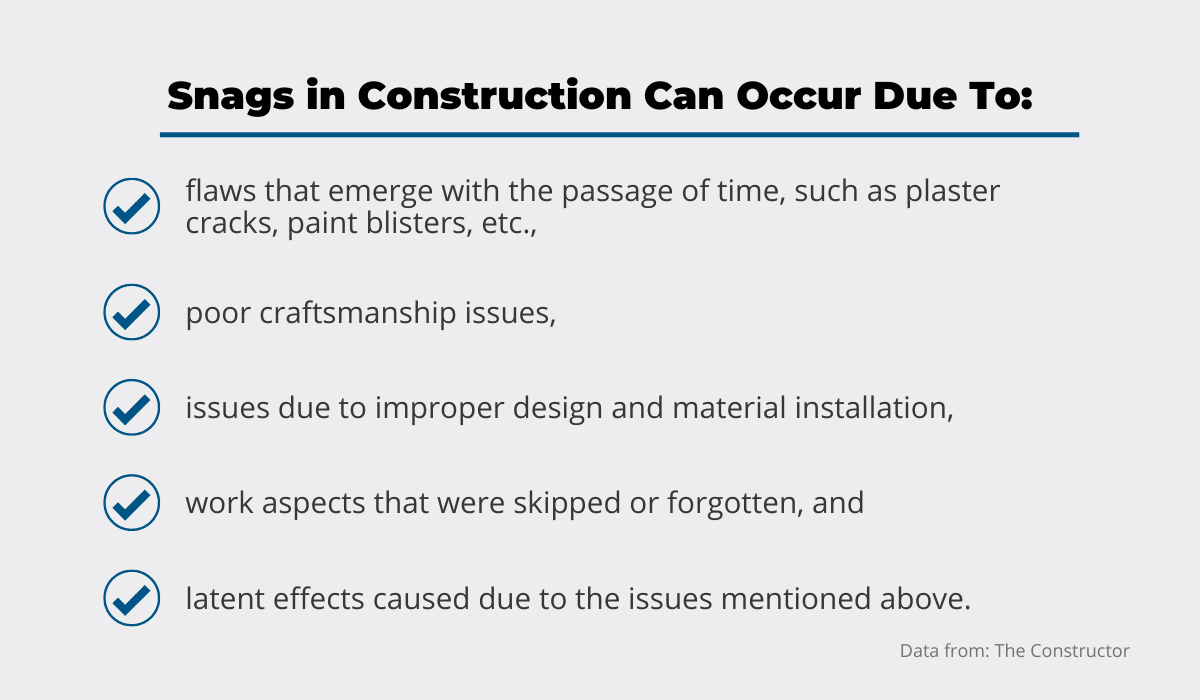
Ideally, you want to gather a construction crew that is great at what they do and provide them with top-notch materials, tools, and equipment.
Despite their best efforts, however, small defects can happen.
That is why it’s important to conduct a snagging inspection toward the end of the construction project, and leave plenty of time for mistakes and defects to be fixed.
The easiest way to do that is with the help of a snagging list.
What Is a Snagging List in Construction
As the construction project nears its completion, it is time to organize a walkthrough with the project owner.
The purpose of the walkthrough is to establish what defects and mistakes need to be fixed before the project can be considered fully completed.
However, it is not enough to skim the property and verbally point out the snags—there needs to be a comprehensive snagging list, which is referred to as a punch list in the United States.
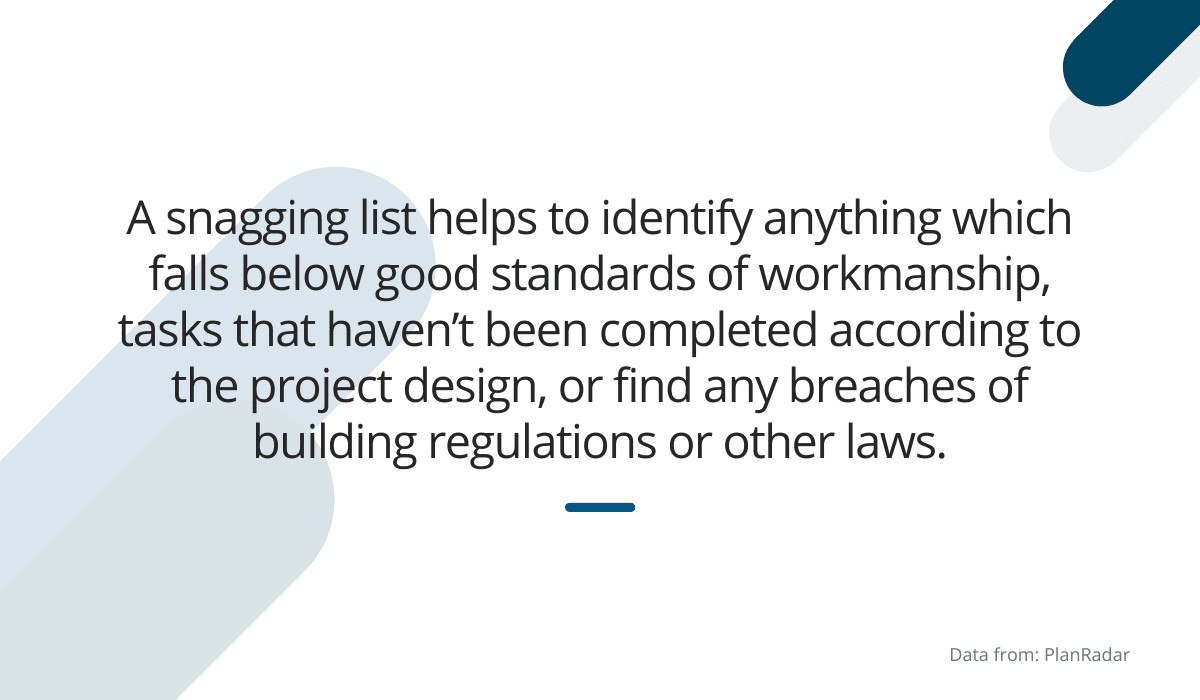
As a contractor, it is your responsibility to go over the list and make sure that all of the defects get addressed.
A snagging list is going to provide both you and the owner with a clear overview of every deficiency that needs rectification in order to ensure that the final result is aligned with what was agreed upon in the contract.
In order to ensure that the snagging list is useful, it needs to contain all relevant information about the defects that need to be fixed.
Take a look at the example below to get an idea of how to format a snagging list.
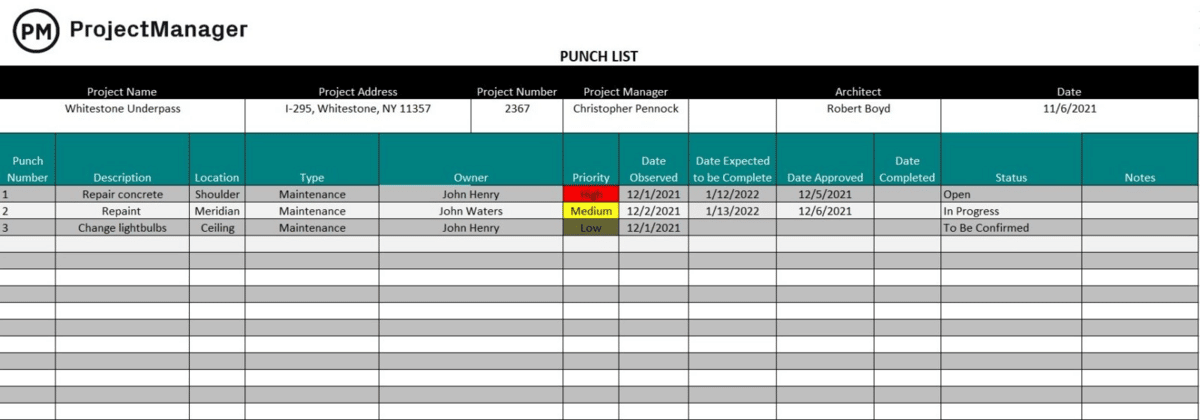
This snagging list was created in spreadsheet format, with each column dedicated to a different piece of information about the snag.
It provides details about what task needs to be completed, where the snag is located, who is responsible for fixing it, how urgent it is to fix it, and its status.
In order to ensure that the list is correct and thorough, we suggest you work on it alongside the architect, the owner or the inspector in charge of compiling the list.
After all, it’s your crew that is going to be fixing the snags, so you want to make sure that no questions are left unanswered.
Who Uses Snagging Lists in Construction
Various persons can be in charge of creating the snagging list. It can be compiled by the project owner, contractor, architect, or even an independent inspector.
Once there’s a list of all defects that need to be fixed, it’s time for other parties to get involved and ensure that it’s put into action.
We will walk you through the snagging process in order to explain exactly which role each of the stakeholders plays in it.
Snagging begins once the contractor has confirmed that their crew completed their part of the job to the best of their ability.
After that, the person or persons in charge of compiling the snagging list (usually including the project owner) inspect the entire property.
This can be done with the assistance of architects and designers, who partake in the walkthrough in order to check whether designs agreed upon in the contract were followed through in the build.
In the event that some of the work is incomplete, or something needs to be repaired, replaced, or touched up, it is added to the snagging list.
According to Property Reporter, about 98% of new build homes have some sort of defect, so the odds of your latest project being completely snag-free are very low.
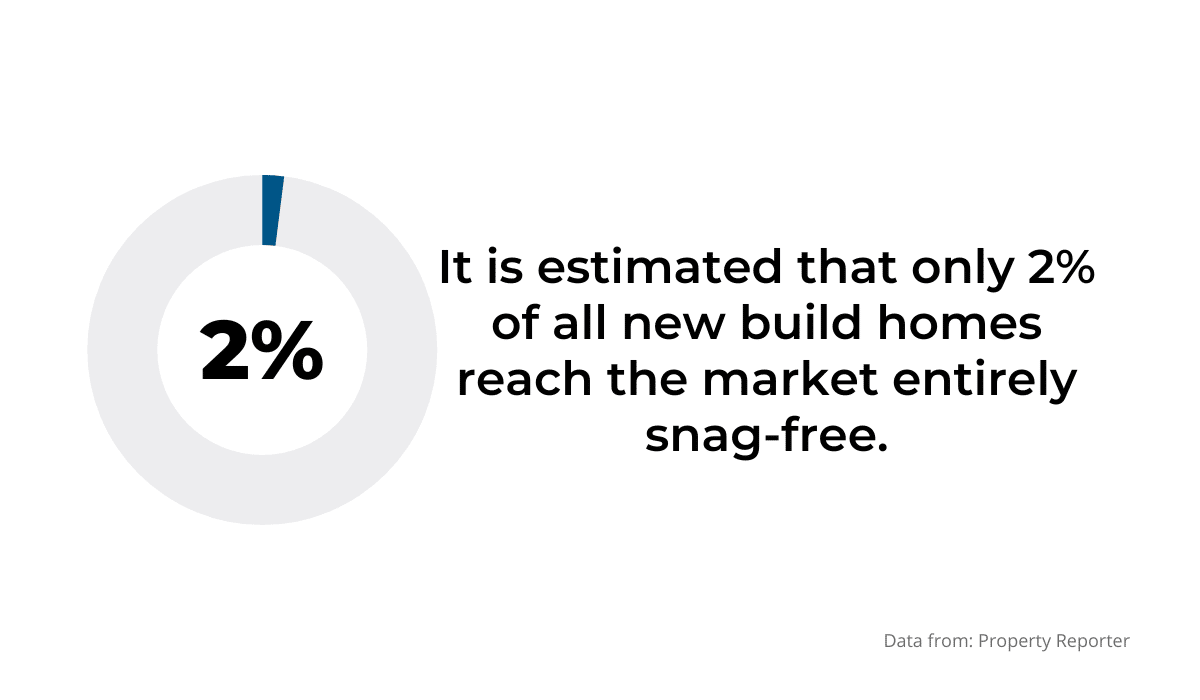
When everything that requires fixing has been added to the snagging list, the responsibility shifts back to the contractors and subcontractors.
The general contractor is tasked with reviewing the snagging list and deciding in which order and by whom the defects are going to be fixed.
Lastly, subcontractors are given access to the snagging list and assigned the responsibility for completing the tasks assigned to them by the general contractor.
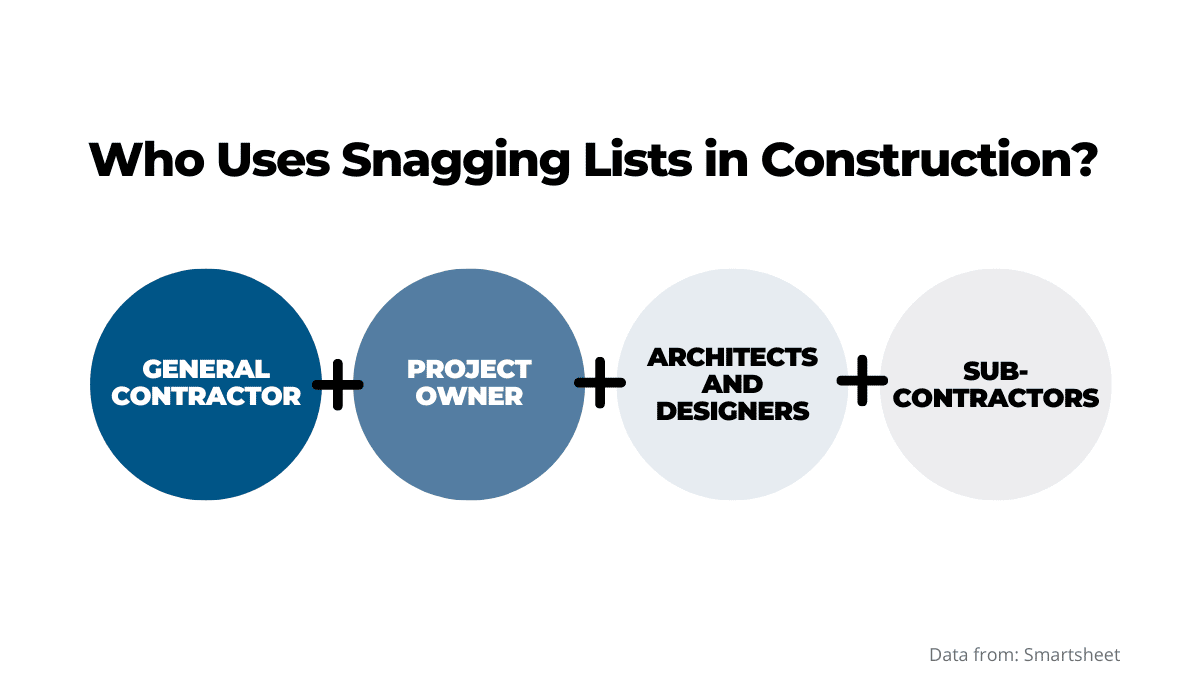
Snagging is a group effort, so everyone involved in it needs to have access to the list in order to stay in the loop about the status of required repairs.
With that in mind, consider using cloud-based software in order to create and share the snagging list.
That way, everyone involved can access the latest information from any device and make sure to complete their tasks on time.
Why Snagging Lists Are Important in Construction
While it is natural for you and your crew to want to do things perfectly the first time around, snags of varying degrees are a common occurrence in construction.
Because they happen so often, a comprehensive and up-to-date snagging list is going to be integral to the success of your project.
Snagging lists ensure that everyone involved in the project is on the same page about what fixes need to be made before the project is completed.
It is advisable that you slowly start working on the snagging list at least a few weeks before the project is supposed to end.
That way, your subcontractors are going to have enough time to fix issues, get paid, and slowly move on to the next project.
According to Sitemate, snagging lists are also “a dispute mediation and regulation mechanism.”
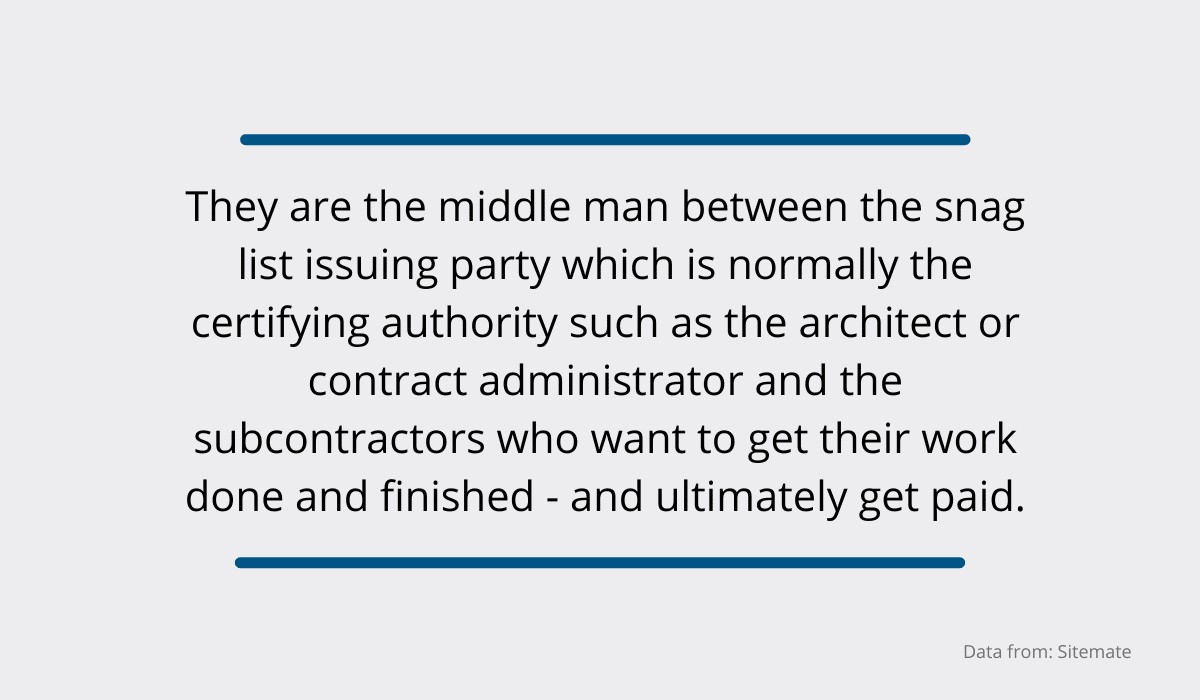
In essence, a good snagging list facilitates open communication between you, your crew, the architect, and the owner.
It allows the owner to share their thoughts about the final build and creates an opportunity for you and your crew to correct any mistakes and deliver optimal results.
Tips for Managing a Snagging List in Construction
While there are no strict rules on what a snagging list should look like, there are some practices you may want to consider that are likely to make snagging list management easier.
We are sharing four things you can do to elevate your snagging list, thus making the entire process more efficient.
Document Problems as You Discover Them
Creating a snagging list isn’t something that should be done at the last minute.
Yes, the project owner might choose to do the walkthrough as the project nears its end, but that doesn’t mean you have to do the same.
Instead, it is advisable to regularly inspect the property and create mini snagging lists (or rolling punch lists) along the way.
76% of individuals who practice snagging continuously throughout the project see the benefits of doing so, reports Autodesk Construction Cloud.
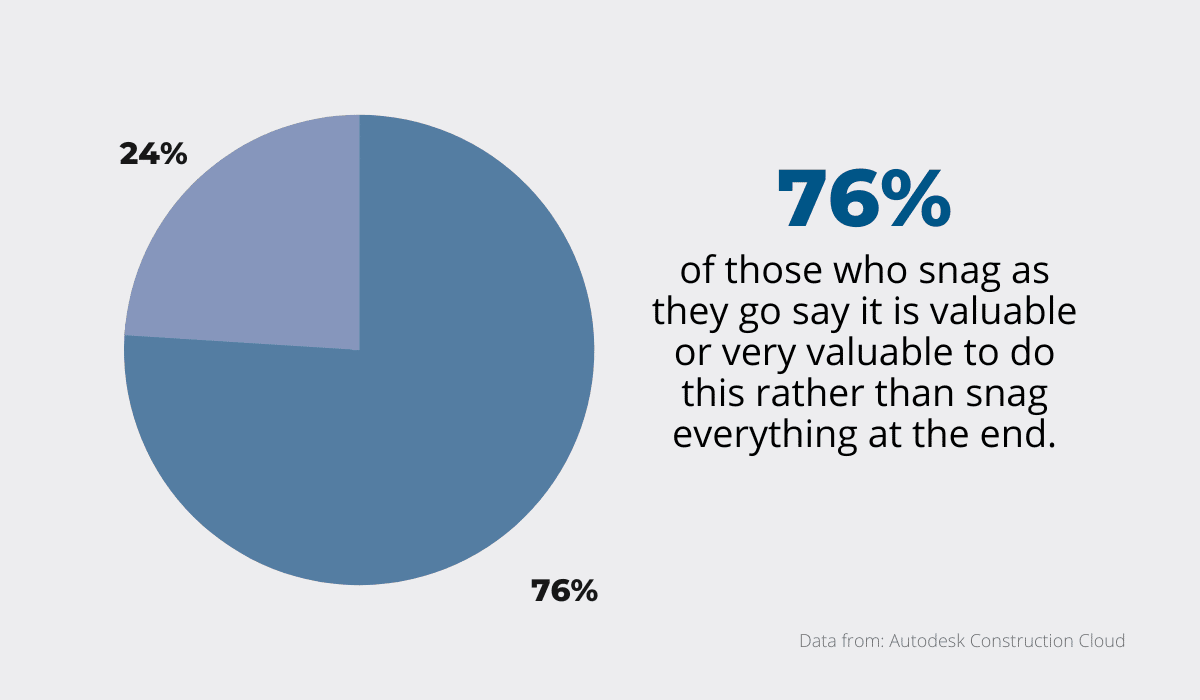
The period towards the end of the project can get very busy and overwhelming for your crew. The last thing they need is to deal with additional tasks when both time and budget are tight.
In order to avoid creating this additional stress, encourage the owner to do regular walkthroughs with you in order to discuss snags as you go.
Documenting issues this way will allow your crew to consistently fix them one by one, thus increasing your odds of finishing the project within budget and on time.
Include Photos in Your Snagging List
A good way to make the snagging process easier for everyone involved is to take photos of defects you come across and include them in the snagging list.
While it is helpful to write down as many details about the snag as possible, a picture might be worth a thousand words in this case.
You have probably found yourself in a situation where you were struggling to accurately describe an issue to someone and ended up saying, “Let me just send you a photo.”
This works well for snagging, too.
According to ArchiSnapper, a punch list management platform, adding photos of defects to your snagging list can help you avoid miscommunication and speed up the process of getting snags fixed.
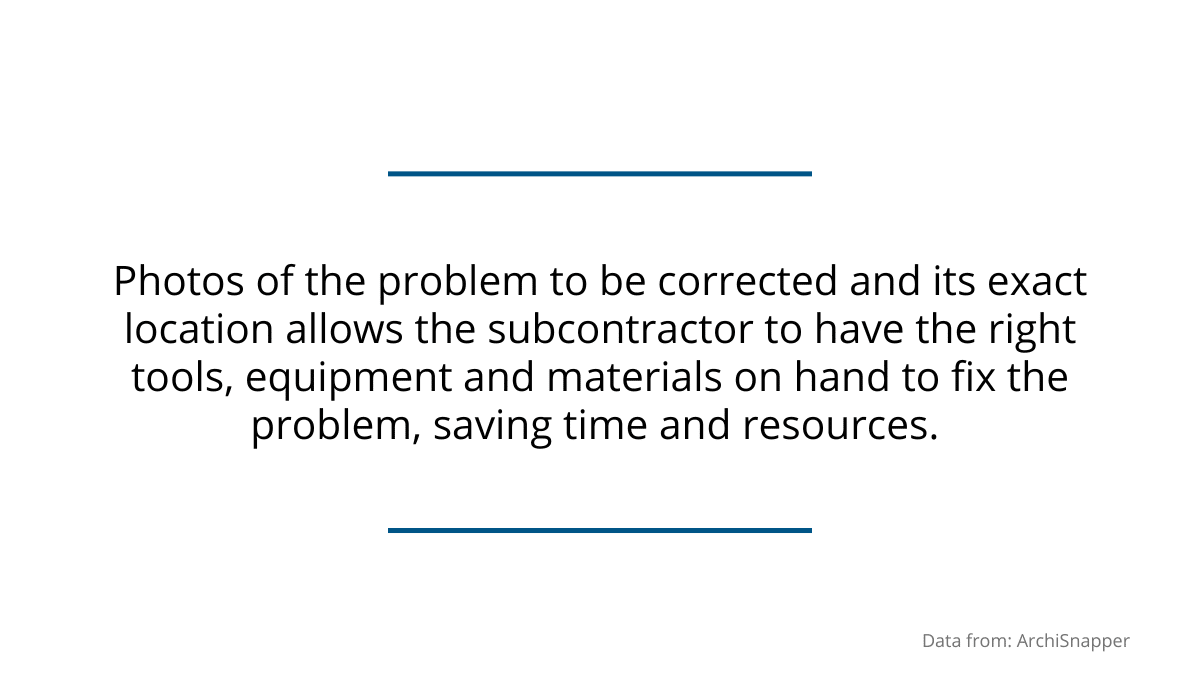
If you add “chipped paint in the back of the living room” to the snagging list, there’s a chance that the subcontractor responsible for fixing it won’t see it or understand exactly where it is.
However, when you add a photo of the snag and specify exactly where it’s located, like in the example below, there’s no doubt about what needs to be done.
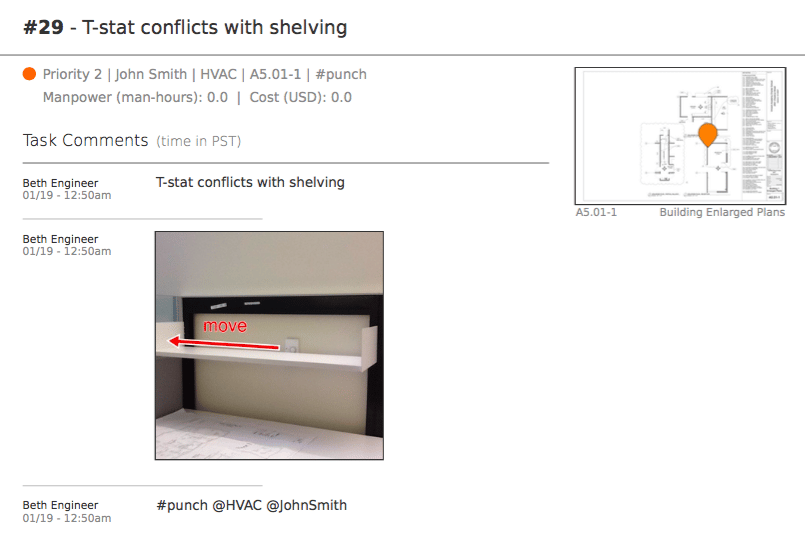
This snagging list item comes with enough details about the issue, but the photo of the snag is what really makes it easier to understand what is going on.
Consider taking a few moments to snap a photo of every snag you come across, as this can significantly improve communication with the crew and ensure the issue gets resolved.
Assign Specific Tasks to Specific Workers
When working in a team, it’s not uncommon for people to assume that someone else will take responsibility for completing certain tasks.
This happens due to a phenomenon called diffusion of responsibility, and construction teams can experience it when they are expected to, for example, complete the items on the snagging list on top of their regular responsibilities.
To ensure that all snags get fixed on time, take some time to assign specific tasks to specific workers.
Being clear about who is in charge of what is going to significantly reduce the likelihood of workers shifting responsibility onto each other.
Dedicate a section of the snagging list to task ownership, such as in the image below.
This snagging list has an “Assignee(s)” section in the top right-hand corner, making it clear that Steve Wood is going to fix the missing baseboard issue.
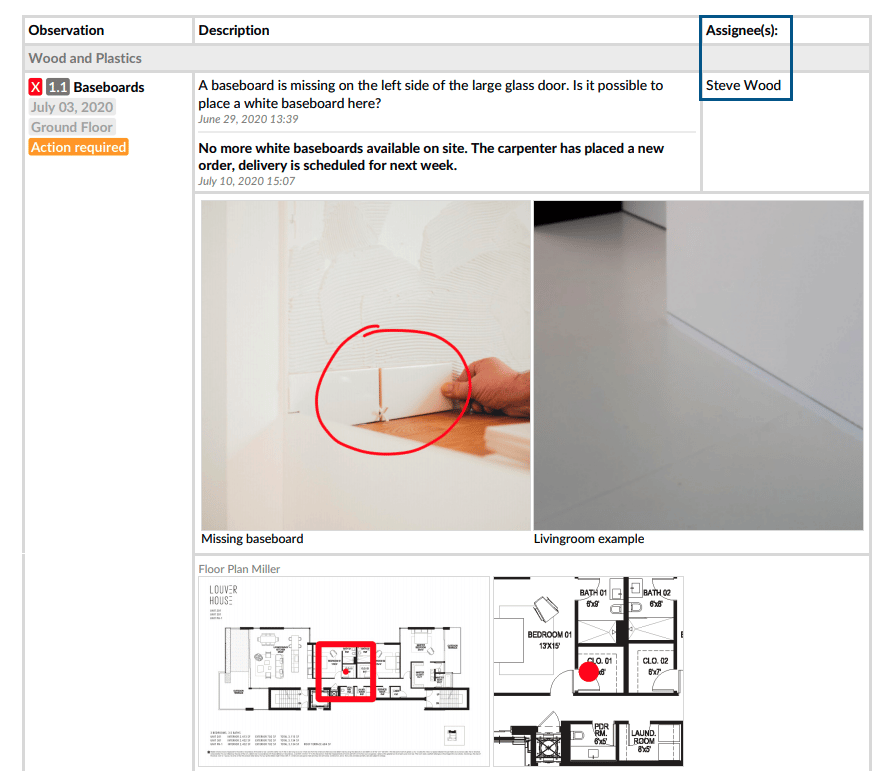
Apart from explicitly stating who is expected to fix the snag, you can also add a due date for each task in order to further facilitate accountability.
When your crew has a number of snags to fix by a specific date, being clear about what needs to be done and by whom is crucial.
Rather than assuming that someone will take care of it, make sure everyone is on the same page about their responsibilities.
Use Snagging Software Tools to Manage Snagging Lists
Creating and managing snagging lists may feel like a daunting task because there are so many factors you need to consider—from due dates and staying within the budget to deciding who should fix the snags.
And while there is nothing wrong with using a piece of paper or an Excel spreadsheet to create your snagging lists, you may want to consider investing in a snagging software tool.
According to a survey conducted by Autodesk Construction Cloud, the large majority of snagging software users find that having such a tool is crucial for the success of the snagging process.
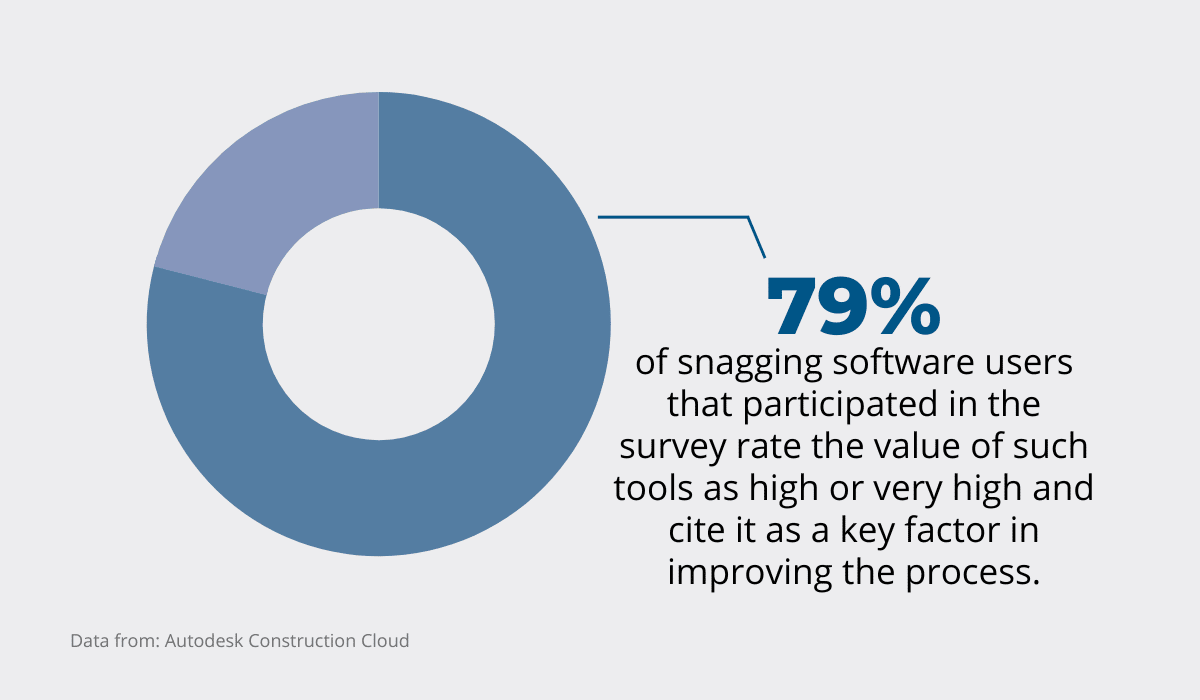
We mentioned earlier that snagging is a group effort that can involve a large number of individuals, and that’s why it’s important for everyone to be on the same page.
Using a snagging software tool such as IssMan, for example, can help with that.
It will allow your crew members to view the list at any time from their devices and provide access to up-to-date information about the snags they’re in charge of fixing.
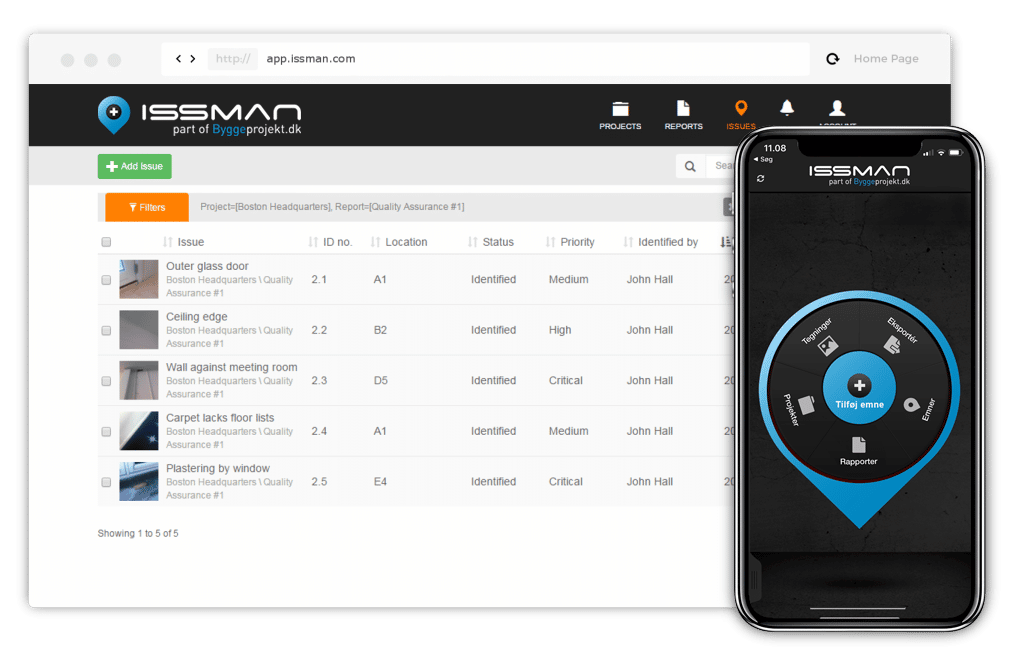
If you’re struggling with snagging list management, investing in snagging software might be a good idea.
It will help you organize information in a more efficient way and ensure the snags get fixed as soon as possible.
Conclusion
Snagging is an integral part of the construction process, and having a well-organized and detailed snagging list can be of great help throughout it.
While snagging is most frequently associated with the very end of a construction project, it’s recommended not to leave it for the very last minute.
Instead, encourage the project owner, the architect, and your construction crew to regularly inspect the property in order to address issues as they arise.
Lastly, try to facilitate accountability within your crew by assigning tasks to specific workers and providing them with access to all relevant information through a snagging software tool.
That way, you’ll ensure that everyone is on the same page, which will make the snagging process easier for everyone involved.









